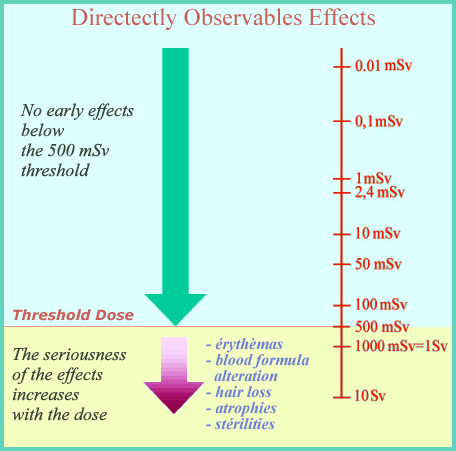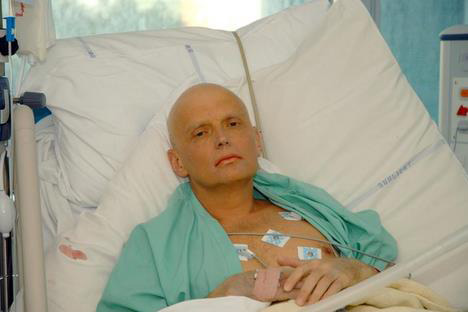The domain of strong doses and severe, reproducible effects

Immediate and reproductible effects
Immediate effects are only observed above a certain threshold of radiation. These effects are called ‘deterministic’ because an identical dose will lead to predictable effects. On the whole body level, the threshold effective dose has been estimated at 500 mSv. On a more localised level, say the testicles, an equivalent dose of 2 mSv can lead to temporary sterility and 6 mSv can make it permanent. On the skin, a dose of 3-8 Sv leads to a passing redness, 7-10 Sv can raise a boil and anything over 10 Sv will often produce necrosis.
© IN2P3/NEPAL(Source Jean Colin)
For high doses above a certain threshold, the damage done is predictable, reproducible and highly widespread. One can predict with a great deal of certainty the effects of high levels of exposure, effects which worsen with increasing dosage. For the whole body effective doses to consider are of the order of sieverts (Sv).
These effects can appear after a few weeks or even days, not an immediate reaction by any means but far quicker than the years which usually characterise the so-called ‘probabilistic effects‘ of low doses of radiation. The predictable effects of these higher doses are known as ‘deterministic’.
Because their impact can be gauged and reproduced, these higher doses are often used in radiotherapy to kill cancerous cells by concentrating the dosage on the tumour in question. Predictably, the effects of the radiation depend on the quantity absorbed.
The relevant unit for this issue is the amount of energy deposited by radiation per kilogram of body mass – the gray (joule/kg). In radiotherapy and curietherapy, the doses are localised and very high, often in the tens of grays, in order to get rid of the malignant cells. In medicine, radiologists consider the amount of energy deposited per kilo.
In the case of an accident which exposes the whole body, the effective dose must be used. If the effective dose is of the order of 1 gray, then deterministic effects can be noticed: these include nausea (at 0.25 gray), hospitalisation (at 0.5 gray) and certain death (from 5 grays).
Most of the people who ever lost their lives to the ill effects of radiation were those killed by the atomic bombs in Hiroshima and Nagasaki. The radioactivity was not the most deadly consequence, however, and most of those who died were killed by the ensuing fire, suffering severe burns or suffocation.
If we set aside Hiroshima and Nagasaki, one rarely comes across victims of high doses of radiation. The most well-known cases are those of the firefighters at Chernobyl who participated in the dousing of the damaged reactor immediately after the accident. Around forty of these firefighters died in the weeks and months that followed. At Tokaimura, two or three of the Japanese technicians responsible for the 1999 accident also died in the ensuing weeks.

An example of deterministic effects
The Litvinenko affair: Alexander Litvinenko was a former KGB officer who was poisoned with polonium 210 in 2006. The very high doses he ingested had clear, reproducible and deadly effects. Litvinenko died on the 23rd of November 2006, about three weeks after having swallowed a poisoned cup of tea while staying at a London hotel. The former KGB agent absorbed several times the lethal dose of polonium, a radioelement some 12 billion times more radioactive than uranium.
© DR
The 2006 poisoning with radioactive substances of the former KGB agent Alexander Litvinenko is another example. Litvinenko was poisoned by consuming a cup of tea containing an infinitesimal amount in grams of polonium 210, but several times the lethal dose in terms of radioactivity. This highly radioactive element is very rare in its natural state, which led to speculation that the polonium was produced in a Russian reactor. It took doctors time to understand what had happened to Litvinenko, as such a poisoning was virtually unheard of. Litvinenko died a few weeks after being exposed.
According to some experts, the dose received was around 2 GBq (50 millicuries), corresponding to the activity of 10 millionths of a gram of polonium 210. The cost of polonium, estimated at 25 million dollars per kilogram by the Berliner Zeitung, fortunately minimises the risks posed by such techniques. For secret agencies, this method of assassination is highly visible and less effective than the classic Bulgarian umbrella dipped in cyanide
Other articles on the subject « Radiation Effects »
Biological Effects
Living matter: both fragile and robust The amount of damage radiation can cause to living matter [...]
Probabilistic effects
The domain of low and average doses For weak or medium-strength doses, the effects are not as cle[...]
Dose-effects Relationship
Can effects caused by low doses of radiations be predicted ? Even though we are constantly expose[...]
Dose Rate
Acute and chronic exposures The “effective dose” is not sufficient by itself to chara[...]
Hiroshima Nagasaki Survivors
An exces of cancers and leukaemia among survivors Our knowledge of the risks of cancers due to ra[...]
Low doses effects
Do low doses of radiation have any effect? Radioprotection experts commonly refer to doses below [...]
Linear No-threshold Model
A Precautionary Principle applied to radioactivity … Is it possible to predict the effects [...]
Radioactive Toxicity
A useful indicator but to be used appropriately … The danger presented by a radioactive sub[...]
Dose Factors
What doses when swallowing or inhaling radioactive atoms ? How to evaluate the doses resulting fr[...]